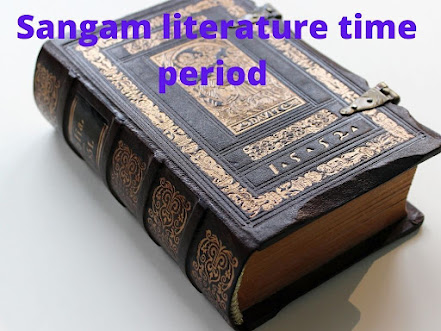Sangam Literature Time Period
There is a discussion of the Tamil poets’ conference in the Madura Mandal or Sammelan. Its first mention comes from the description of Irayyanar Agapporul (8th century). The Tamil tradition describes three literary councils. They were held in the capital of the Pandya kings.
Second Sangam- It was held at Kavattapuram or Kapatapuram. It was headed by Agastya and Tolkapiyam. All its works were destroyed, leaving only one Tamil grammar Tolkapiyam.
The third Sangam was held in Madurai. Nakirr presided over it. The literature composed in the third Sangam is compiled into eight collections. These are called Aittutogai. The names of the eight texts are as follows-
Nanninai – There are 400 short poems on love.
Kurunthokai- 400 poems on love.
Engurunoor – 500 poems on love by Killar.
Padituppattu- There are eight poems in praise of the Chera kings.
Paripadal – There are 20 poems in praise of the deities.
Karitogai – 150 poems.
Ahananuru – There are 400 poems composed by Rudrashraman.
Purananuru – There are 400 poems in praise of the king.
What is Sangam Literature?
The above-mentioned eight texts and ten village songs are known as Melakanku. These ten village songs are compiled in Patupatu. Melakanku narrative literature has been called.
In addition to 102 names in the entire collection, there are 2279 works of 473 poets. The length of the poems ranges from 4-5 lines to 800 lines. The names of their creators have also been given and information about the occasion of their creation has also been given. However, in the Tamil Tikas of Sangam, written in the 8th century, it is said that the three Sangams lasted for 9990 years. 8598 poets participated in it and 197 Pandya rulers were their patrons. There are several grounds for the classification of these compositions. One basis for the classification of compositions is that it is divided into Agama and Puram. There is also a second basis for their division related to agama (intimate) love, Puram (external) – related to the praise of kings and this division has also been done according to the region. The entire literature is divided into five tinai (regions)-
1. Kurunji (Mountain) – for poems related to premarital love and animal attacks. In this, the basis of the economy was hunting and gathering. This caste community was for Karwar and Belat.
2. Palai (Palai) (Waterless Place) – This was for a long separation of lovers and a poem that destroyed the rural side. There was an economic activity – hunting and robbery. Jati-Aniar and Marwar were its community sides.
3. Mullai (Mullai) (Jungle) – Mullai was used for the short-term separation of forest lovers and for the adventurous journey of invasion. Its economic activity was related to animal husbandry, jhum cultivation. The caste and community were the shepherds (Ayer and Itair) etc.
4. Marudam-(Plowed ground for agriculture)- This was for love after marriage or for the fraudulent behavior of prostitutes. Its economic activity was agriculture and allied aspects. The castes associated with it were Usvar and Vellar.
5. Neytal-(Beach)- It was used for separation of wife and permanent war of fishermen. Its economic activities were fishing, pearl extraction, salt making. There is a lot of controversy regarding the composition of the caste-fisherman’s (Partwar) Sangam literature. Pro. Nilakath Shastri places these compositions between 100 AD to 300 AD. According to Srinivasa Aygar, Sangam literature dates back to 500 BC. and is written between 500 AD. Ram Sharan Sharma considers it to be composed between 300 AD and 600 AD.
Kilkanku – There are 18 short texts in this. Aryan influence is visible to a great extent in the second layer of Tamil literature. The predominance of Jain influence is pervasive. This literature is ethical. Two of them, Tirukkural and Naldiyar, are important. Tirukkural has been called the bible of Tamil literature. Kilkanku literature was called didactic literature.
The third type of literature – epic – around the 6th century AD, the effect of Ayya was seen on the entire Tamil land. Tamil poets also started writing big poems. They have been addressed by the Sanskrit name Kavya.
The first book is Shilpadikaram. This composition has been considered as the national poem of the Tamil people. The ruler of Sri Lanka Gajabahu is also discussed in Shilpadikaram. He is believed to have been present when a temple for Kannagi was being established by Sengutuwan.
Shilpadikaram means the story of Nupur. It was composed by Ilagoadigal, the younger brother of the Chera ruler Shenguttuvan. The plot of this book is based on Kovalan, a merchant of Puhar (Kaveri Pattanam). Kovalan was married to Kannagi. Later, Kovalan meets a prostitute named Madhavi. Kovalan forgets Kannagi while in love with Madhavi. When he comes to his senses after spending all his wealth, he returns to his wife. Kannagi gives him a Nupur of hers, after which both of them come to Madura with the desire of business. A similar Nupur, the queen of Madura, is lost and Kovalan is sentenced to death on a false charge. Later, the entire city is consumed by Kannagi’s curse. Kannagi posthumously reunites with Kovalan in heaven.
The second epic is Manimekhalai. It was composed by Sarotha Vaishtanar, a grain merchant from Madura. He was a Buddhist. The heroine of Manimekhalai is Manimekhalai, the daughter of Shilpadikaram’s hero Kovalan’s daughter-in-law to Madhavi, a prostitute. Madhavi becomes a Buddhist upon hearing the news of Kovalan’s death. On the other hand, Manimekhalai protects her chastity through Prince Udayan. Later she too becomes a Buddhist nun at the behest of her mother.
The third epic is Jivaka Chintamani. Its author is Tirutkkadevar. It describes the wonderful work of a warrior like Jivaka. But in the end, he embraces Jainism. Shilpadikaram and Manimekhalai are influenced by Buddhism and Jivaka Chintamani from Jainism.
